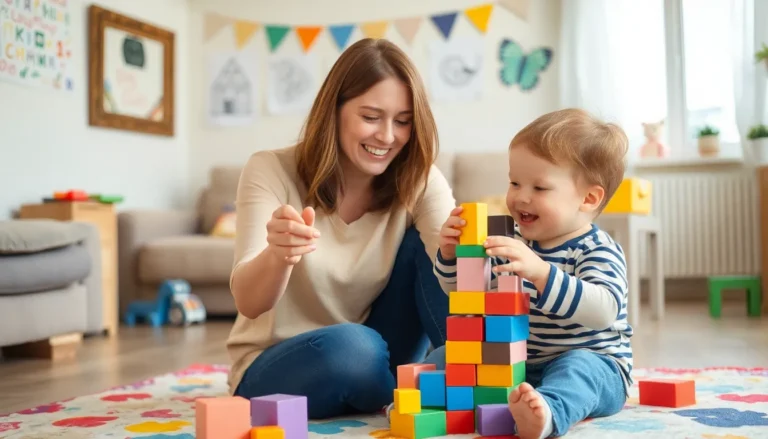Table of Contents
ToggleTeen sibling relationships can be a wild ride, filled with laughter, rivalry, and the occasional eye-roll. As they navigate the tumultuous waters of adolescence, these siblings often find themselves in a unique bond that’s both a blessing and a curse. One moment they’re sharing secrets and inside jokes, and the next, they’re locked in an epic battle over the last slice of pizza.
Understanding Teen Sibling Relationships
Teen sibling relationships exhibit both depth and complexity. The interactions during these formative years shape their future connections significantly.
Importance of Sibling Bonds
Sibling bonds provide crucial emotional support during adolescence. These relationships cultivate companionship and understanding, helping teens navigate life’s challenges. From sharing secrets to offering advice, siblings often serve as trusted confidants. They benefit from learning conflict resolution skills through both disagreements and reconciliations. Researchers indicate that positive sibling interactions contribute to better mental health outcomes in adulthood. Emotional resilience often stems from these early relational dynamics.
Common Dynamics Among Teens
Common dynamics include rivalry, collaboration, and affection, creating a unique blend of interactions. Sibling rivalry frequently arises from competition for attention or resources, leading to conflicts over issues like chores or shared possessions. At the same time, collaboration shines through shared interests, such as hobbies or school projects. Moments of laughter and joy strengthen their bond, even amidst disagreements. As they transition into adulthood, many siblings develop deeper connections rooted in mutual respect and understanding, paving the way for lifelong friendships.
Factors Influencing Relationships

Multiple elements shape teen sibling relationships, significantly affecting their dynamics. Key influencers include age differences and distinct parenting styles, which create unique interaction patterns.
Age Differences and Their Impact
Age differences among siblings play a substantial role in their relationships. Older siblings often take on protective, mentoring roles, guiding younger siblings through challenges. Conversely, younger siblings gain opportunities to learn from their older counterparts, adapting behaviors and interests. Disparities can lead to rivalry in some cases, yet they might also foster collaboration on shared goals. An age gap of three years tends to facilitate positive interactions, while larger gaps may result in disconnects. Each sibling may experience varying levels of autonomy and responsibility influenced by their age, creating a complex but rewarding bond.
Parenting Styles and Sibling Interaction
Parenting styles significantly influence how siblings interact and relate to each other. Authoritative parenting, characterized by clear boundaries and support, fosters better communication among siblings. In families where parenting approaches vary, conflict may arise due to inconsistent expectations. Siblings under permissive parenting often negotiate for attention, leading to rivalry. Consistent use of similar parenting strategies can strengthen sibling bonds, promoting collaboration and respect. Families that encourage open dialogue allow siblings to express feelings, enhancing emotional connections. These patterns ultimately contribute to healthier sibling relationships and personal development.
Positive Aspects of Teen Sibling Relationships
Teen sibling relationships offer unique benefits that significantly influence personal growth and development. These relationships provide emotional scaffolding that helps teens navigate the ups and downs of adolescence.
Emotional Support and Companionship
Emotional support thrives in sibling relationships during teenage years. Siblings often become trusted confidants, enabling them to share secrets and express fears in a safe space. They listen and provide comfort during difficult times, which lessens feelings of loneliness. Research shows that strong emotional ties among siblings enhance mental well-being, contributing to healthier emotional regulation in adulthood. Trust nurtures a sense of belonging, with siblings celebrating each other’s successes and offering solace during setbacks. Encouraging open dialogue fosters deeper connections, allowing teens to develop empathy and understanding.
Joint Activities and Shared Interests
Joint activities strengthen sibling bonds, creating memorable experiences. Engaging in hobbies or sports fosters teamwork and cooperation, which enrich relationships. Exploring common interests, such as video games or music, enhances their connection, making everyday activities more enjoyable. Sharing these interests often leads to laughter, reinforcing positive interactions. Participating in family outings or joint projects cultivates collaboration, teaching valuable life skills like communication and negotiation. Through these shared experiences, siblings forge lasting memories that contribute to a solid foundation for future relationships.
Challenges in Teen Sibling Relationships
Teen sibling relationships face numerous challenges that can impact their connections. Rivalry often arises as siblings vie for parental attention and resources. Each sibling may feel a need to prove their worth, leading to competition in academics, sports, or personal achievements. Heightened jealousy can complicate interactions, creating friction even among close companions. Parents frequently become involved, intentionally or unintentionally fueling the competition by comparing siblings or favoring one child.
Communication barriers also contribute to challenges. Often, misunderstandings stem from differences in communication styles. Siblings may not effectively express their feelings or concerns, leading to unresolved conflict. Misinterpretation commonly occurs, especially during emotionally charged discussions. Additionally, reluctance to confront sensitive topics can create an emotional distance, limiting emotional support. Open dialogue is crucial; however, fear of judgment or dismissal can hinder honest conversations. Addressing these barriers fosters better understanding and ultimately strengthens sibling bonds.
Strategies for Strengthening Sibling Bonds
Strengthening sibling relationships involves intentional efforts to foster connections and enhance communication. Two effective strategies include encouraging open communication and engaging in shared family activities.
Encouraging Open Communication
Siblings benefit from open dialogue. Encouraging teens to express their feelings creates an environment where they feel heard. Creating safe spaces for discussions helps them voice concerns without fear of judgment. Regular check-ins allow siblings to address issues before they escalate. Prioritizing honesty fosters trust, making it easier to navigate conflicts together. Additionally, active listening enhances understanding, leading to deeper connections.
Shared Family Activities
Participating in shared family activities strengthens sibling bonds. Engaging in hobbies promotes teamwork and creates lasting memories. Family game nights or outdoor adventures encourage collaboration, enhancing relationships. Cooking together can be another bonding experience, teaching cooperation and patience. Prioritizing quality time reinforces connections and allows siblings to explore common interests. Developing traditions, like movie nights, fosters unity and creates a sense of belonging. Fun, shared experiences provide a foundation for lifelong friendships among siblings.
Teen sibling relationships play a vital role in shaping emotional well-being and social skills. Through shared experiences and challenges, siblings learn valuable lessons in communication and conflict resolution. These bonds often evolve into lifelong friendships that provide support during difficult times.
Fostering open dialogue and engaging in family activities can enhance these relationships, promoting mutual respect and understanding. As siblings navigate the ups and downs of adolescence together, they not only strengthen their connection but also build a foundation for future interactions. The journey through rivalry and collaboration ultimately leads to deeper ties that can enrich their lives for years to come.







